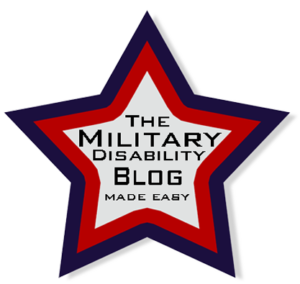On March 20, 2025, we will stop accepting new Military Disability Made Easy subscriptions. For more information about how this change may impact your subscription, click here
VA Exam Medical Histories – Two Simplifying Tips for Both Docs and Vets
- Published:
- Last Updated: October 4, 2022
 I recently had a physician who performs C&P Exams for VA Disability ask about the best, fastest way to write a patient’s medical history.
I recently had a physician who performs C&P Exams for VA Disability ask about the best, fastest way to write a patient’s medical history.This is an excellent question. Physicians on the whole spend an immense amount of time writing their reports, sometimes more time than they spend with the patient. This is because it is often very important for things to be recorded correctly, especially when it comes to disability. But is this really the best use of their time? Are there ways to speed up the recording process so physicians are free to spend more time with their patients?
Recording a patient’s medical history in a C&P Exam is important, but can be incredibly time-consuming. There are certain things that the VA must know in order to determine a case correctly. If information is missing, they’ll either misjudge the case or send it back for the missing info (thus causing a significant delay in the processing time).
Now, it is true that the medical history on the C&P Exam is not the only evidence that should accompany a claim. In fact, it can’t be. Service treatment records (STRs) are the legally required proof that every claim must have. However, a good summary of the necessary information recorded by the physician performing the C&P Exam can actually make the processing time speed up since the Rating Authoritywon’t have to dig so hard for the pertinent info. They’ll read it, find it quickly in the STRs, and done. No having to scrutinize every single STR submitted. The Rating Authority is also much more happy (a really good thing—you want the people deciding your future to do it in a good mood, believe me). Going through a ton of paperwork stinks.
Veterans, it is good for you to know these tips because, let’s face it, not all of your physicians will read this blog. By knowing what to record, you can make sure it happens. This is your disability, after all, and so it is ultimately your responsibility that it’s done correctly. This does not give you permission, however, to condescend or disrespect your physician. Please be careful how you talk to your doctor. You want them on your side. That being said, you have the right to get it done right.
So, we’ve established that it’s good to have a quality medical history, but quality doesn’t mean it has to be long and take forever to write. In order to save the physician a great deal of time, speed up a claim’s processing time, and create a happy Rating Authority, here are two quick tips to writing a medical history.
1. Establish service-connection. The number one most important thing to record in the medical history is how the condition is service-connected. The VA can only compensate conditions that are service-connected, and so whatever information is needed to prove service-connection is essential. If the condition was acquired or diagnosed while the vet was on active duty, then just draw attention to this fact in the history. If, however, the condition was not acquired during service, but is caused by another service-connected condition, then this relationship is essential to highlight.
The amount of information for this does not have to be large, just quality. A single sentence may be enough: “The veteran first broke his tibia during exercises while on active duty on November 14th, 2004” or “While in the military, the veteran was diagnosed with pulmonary tuberculosis. The veteran was separated from the military July 21st, 2006. On March 15th, 2007 he was diagnosed with interstitial lung disease secondary to his service-connected pulmonary tuberculosis.” The last example was weak medically, but the point should be clear. Establishing service-connection is essential, but short and sweet is totally fine.
2. Record the Rating Criteria. After service-connection is established, the only other things that matter are the details that are essential for rating the condition. Every single doctor’s visit or exacerbating event isn’t necessary. The Rating Authorities will have access to all these medical records, so everything does not have to be reproduced. Since the VA will mostly use the information recorded in the C&P Exam to rate the condition, the only additional history that must be recorded is details that will assist or are pertinent to the ratings. This exact information will be different for every condition, but guess what?! There’s a website for that: www.MilitaryDisabilityMadeEasy.com. Just look up the condition, figure out what is necessary to rate it, and make sure it’s included in the history.
For example, aplastic anemia, code 7716, is rated on the regularity of transfusions or infections. In this case, the one-time C&P Exam data won’t be as important as the history of the frequency of transfusions or infections. The history should then clearly note that “the veteran has a history of receiving transfusions once every 3 months,” etc. That is how the condition is rated, so that is the important information to include in the history. And that’s all that needs to be included. The rest does not matter since it isn’t pertinent to the ratings.
Another example, let’s say a veteran acquired a knee injury while on active duty. At the C&P Exam, he only displayed limited motion, but he has a history of instability with frequent dislocations. The majority of knee conditions are rated on limited motion, and in most cases, only one rating can be given for a knee condition. In this case, however, the history of instability is essential to include in the history because instability CAN be rated in addition to limited motion. It is the only knee code that can be given in addition to other knee ratings. Thus, the history of instability is definitely essential to record. It is not essential, however, to list every range of motion exam he ever had since the VA only cares what his range of motion is right now (the C&P Exam).
So, there you have it. Two tips to writing a quality, fast medical history for a C&P Exam.
The more you start thinking as a rater, and thus figuring out what is needed to rate the condition, the more you’ll [hopefully] be able to speed up the time it takes to write your histories, only spending time on the pertinent info and skipping all the rest. When in doubt, however, it is probably best to include it than not.
Recent Posts
TDRL vs. PDRL—Which is better for disability benefits?
February 13, 2025
Leukemias and Multiple Myelomas NOW on the Presumptive List
January 9, 2025
Two MORE Conditions added to the Burn Pit Presumptive List
January 3, 2025
The 2025 VA Disability Rates are here!
December 2, 2024
About Us










2 Comments
sir I was wonder what I should list as a disability for the VA that sent me a question asking me to list a specific disability for my gulf war syndrome,,,,,i don't know what to respond can you help??? regards
Hi Matthew –
You just need to tell them what conditions you have that you are considering Gulf War Syndrome. Just serving in the Gulf War doesn't give you a disability. Gulf War Syndrome is a title that just groups together various conditions. The VA needs to know what those conditions are in order to rate them.